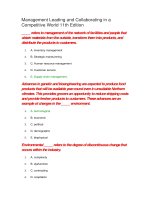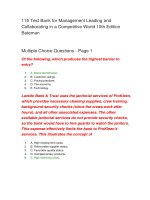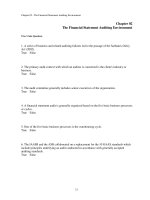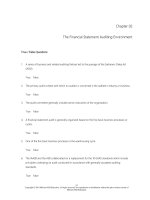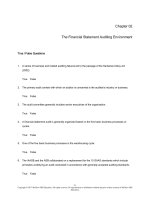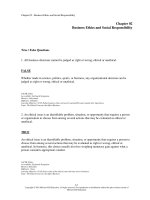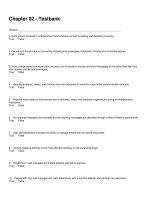Management leading and collaborating in a competitive world 10th edition bateman test bank
Bạn đang xem bản rút gọn của tài liệu. Xem và tải ngay bản đầy đủ của tài liệu tại đây (569.21 KB, 188 trang )
Chapter 02
The External and Internal Environments
True / False Questions
1. Organizations are open systems that affect and are affected by their external
environments.
True
False
2. The external environment includes all relevant forces outside the organization's
boundaries.
True
False
3. Strategy is an example of an input to an organization.
True
False
4. A firm's competitive environment includes new entrants, as well as substitutes and
complements.
True
False
5. An organization's macroenvironment includes its customers and suppliers.
True
False
6. When investors bid up stock prices, companies have less capital to fuel their
strategies.
True
False
7. While the stock market can impact a firm, it has no effect on the behavior of
individual managers.
True
False
8. Firms that develop strategies that do not include technological advances will
realize obsolescence and extinction.
True
False
9. U.S. government policies both impose strategic constraints and provide
opportunities for organizations.
True
False
10. Regulatory agencies set rules but are typically weak institutions since they do not
have the power to investigate company practices or to take legal action to ensure
compliance with the law.
True
False
11. Social metrics are measures of various characteristics of the people who make up
groups or other social units.
True
False
12. The fastest-growing age group in the U.S. civilian labor force is the group between
30 and 40 years old.
True
False
13. Despite government crackdowns, immigration is one reason why the labor force
will be more ethnically diverse in the future than it is today.
True
False
14. The percentage of women participating in the U.S. workforce has increased sharply
since 1999.
True
False
15. A more diverse workforce presents managers with challenges as well as
opportunities.
True
False
16. Family leave, flexible working hours, and child care assistance have been
introduced as a direct result of the growing ethnic diversity in the workplace.
True
False
17. Porter's model for competitive analysis is one example of analyzing the
competitive environment for adapting to and even influencing the nature of
competition.
True
False
18. Red Bull, an energy drink, is a competitor to Pepsi.
True
False
19. The first question in understanding competitive environments from Porter's model
is "How strong is the competition?"
True
False
20. A barrier to entry is a condition that prevents customers from using a firm's
products or services.
True
False
21. According to Porter's model, Netflix streaming video would be considered a
substitute for Blockbuster DVD rental.
True
False
22. Landscaping products are complements when people are buying new homes.
True
False
23. Powerful suppliers can increase a buying organization's profits, especially when the
organization must hold prices steady for its customers.
True
False
24. Needing to learn a new software program as a result of changing suppliers is an
example of a switching cost.
True
False
25. Input chain management is the managing of the network of facilities and people
that obtain materials from outside the organization, transform them into products,
and distribute them to customers.
True
False
26. The goal of supply chain management is having the right product in the right
quantity at the right place at the right cost.
True
False
27. The Internet has empowered customers by providing an easy source of
information.
True
False
28. Environmental scanning means sorting through information available to the public
to interpret what is important and what is not.
True
False
29. Competitive intelligence is also known as corporate espionage.
True
False
30. Benchmarking means comparing your processes to the best-in-class performance
by a company in a given area.
True
False
31. Organizations that are defenders are more likely to engage in strategic
maneuvering than are prospectors.
True
False
32. April, a manager in a call center, encourages her employees to solve customers'
problems without her approval of the particular situation. Here April has
empowered her employees.
True
False
33. Southwest Airlines demonstrates the independent action strategy known as
competitive pacification by cutting fares when it enters a new market.
True
False
34. In a dynamic environment, bureaucratic organizations are more efficient than
organic organizations.
True
False
35. A strong organization culture is one in which everyone understands and believes in
the firm's goals, priorities, and practices.
True
False
36. Stories told by employees almost never have any connection to the true culture of
the organization.
True
False
Multiple Choice Questions
37. Organizations that are affected by and that affect their environment are called
A. Input systems.
B. Output systems.
C. Open systems.
D. Closed systems.
E. Social systems.
38. Liz, a new manager at Stamford Soft, has been asked to focus on the competitive
environment of the organization. Which of these factors is among those on which
Liz should focus?
A. Government legislation.
B. Culture.
C. Demographics.
D. Buyers.
E. Technology.
39. The economy is a crucial component of the macroenvironment. Which of the
following statements is most true about economic macro effects?
A. The impact of changes in the economy is predictable to competitors.
B. There are complex interconnections among the economies of different
countries.
C. Changes in the economy are impossible to quantify.
D. High-level managers have little awareness of economic indicators.
E. The economy has no macro effects on managers.
40. Interest rates, inflation, the federal deficit, and unemployment levels are all
elements in which aspect of the macroenvironment?
A. The social environment.
B. The demographic environment.
C. The international environment.
D. The regulatory environment.
E. The economic environment.
41. New methods of communication, production, and even the development of entire
new industries are the results of the changes in
A. Demographics.
B. Societal preferences.
C. Politics.
D. Technology.
E. The economy.
42. Advances in genetic engineering and biotechnology are expected to produce
some food products that will be available year-round even in northern climates.
This provides grocers an opportunity to reduce shipping costs while at the same
time offering fresher produce to customers. These advances are an example of
changes in the
A. Technological environment.
B. Economic environment.
C. Political environment.
D. Demographic environment.
E. Ecological environment.
43. Managers with ready access to information
A. Increase costs.
B. Are able to manage and communicate more effectively.
C. Are in danger of losing power to rivals or suppliers.
D. Decrease their span of control.
E. Always increase sales.
44. Using international bribery as a business tactic may result in fines for U.S. firms.
This statement reflects which type of environmental force at work?
A. Competitive.
B. Economic.
C. Legal/political.
D. Societal values.
E. Demographics.
45. Armando was recently hired as the workplace safety compliance officer at Preston
Mining Company. Armando will have the responsibility to monitor regulations from
which of these government agencies?
A. FCC.
B. EPA.
C. SEC.
D. OSHA.
E. NLRB.
46. The SEC recently proposed regulations requiring companies to disclose more
details about executive compensation. This illustrates an important interaction
between organizations and their relevant
A. Demographics.
B. Regulators.
C. Attorneys.
D. Labor officials.
E. Suppliers.
47. Measures of various characteristics of the people who make up groups or other
social units are called
A. Psychographics.
B. Demographics.
C. Social characteristics.
D. Lifestyle analytics.
E. Unit characterization.
48. Which of the following statements about workforce demographics is true?
A. Training of entry-level workers is not needed in today's modern workplace.
B. Workforce demographics have little to do with human resource strategies.
C. Older, experienced workers are likely to be relatively scarce over the next five
years.
D. Population growth influences the size and composition of the labor force.
E. Technical tasks can be sent overseas to be accomplished, but companies usually
then have to pay more for labor.
49. __________ trends regarding how people think and behave have major implications
for management of the labor force, corporate social actions, and strategic
decisions about products and markets.
A. Psychological
B. Political
C. Economic
D. Technological
E. Societal
50. A company that is concerned with the quantity and quality of resources available
for its business processes will investigate which factor in the macroenvironment?
A. The natural environment.
B. The social environment.
C. The demographic environment.
D. The regulatory environment.
E. The economic environment.
51. Which of the following is an element of Porter's model for analyzing the
competitive environment?
A. Substitutes and complements.
B. Cost strategy.
C. Potential customers.
D. Regulatory forces.
E. SBU strategy.
52. The competitive environment consists of
A. The firm and its rivals, suppliers, customers (buyers), new entrants, and
substitute or complementary products.
B. Only those organizations on which the focal organization to provide supplies
and materials.
C. The workers of the organizations that complete the organization's activities.
D. The organizations that hold the firm accountable to their stakeholders.
E. The broader influences that affect a firm's competitive advantage.
53. A firm's current competition, suppliers, customers, and the threat of new entrants
or of substitutes are all elements in the
A. Task environment.
B. Peters model for organizational excellence.
C. Microenvironment.
D. Porter model for competitive analysis.
E. Industrial microenvironment.
54. A low-cost airline described as one of the excellent companies in the bestseller of
the early 1980s, In Search of Excellence, is no longer in business. Industry analysts
state that although the service and prices provided by the airline were what
customers wanted, the larger airlines were able to drive the low-cost airline out of
business through an aggressive price war. This scenario is illustrative of which
aspect of the competitive environment?
A. Customers.
B. Rivals.
C. Regulators.
D. The economy.
E. Social trends.
55. Walmart recently engaged Amazon.com in a price war, offering best-selling books
for first $10, then $9; and now Target has jumped into the war with best sellers for
$8.98. This scenario is an example of which aspect of the competitive
environment?
A. Customers.
B. Competitors.
C. Regulators.
D. The economy.
E. Substitutes.
56. Which of the following is a competitor that a mass merchandiser like Target must
identify and anticipate the actions of?
A. Consumer advocacy groups.
B. Mass merchandiser suppliers.
C. Wholesale outlets like Sam's or Costco.
D. Companies entering new markets.
E. All of these are potential competitors.
57. Conditions that may prevent new firms from entering an industry (e.g., the use of
patents) are referred to as
A. Barriers to entry.
B. Roadblocks.
C. Unfair trade practices.
D. Insider trading.
E. Trade protectionism.
58. Hospitals and universities are very expensive to run not only due to the capital
equipment that is required for each, but also due to the personnel such as
specialized medical doctors and researchers. The cost of these types of institutions
is an example of
A. Enhancing barriers to entry.
B. Eliminating protectionism.
C. Unfair competition.
D. Enhancing trade protectionism.
E. Eliminating barriers to entry.
59. Of the following, which produces the highest barrier to entry?
A. Brand identification.
B. Customer ratings.
C. Pricing practices.
D. The economy.
E. Technology.
60. The development of new products that may replace sales of existing products is
referred to as the threat of
A. New entrants.
B. Substitutes.
C. Enhanced supply.
D. Technology.
E. Complements.
61. When microwave ovens were first introduced, they posed a potential threat to
conventional oven producers. But the effect of microwaves on the sales of
conventional ovens has been minimal; in fact, most homes today utilize both
appliances. Oven technology has not advanced much lately and industry profits
are flat. Based on this information,
A. The threat of new entrants for either type of oven is high.
B. The threat of competitive rivalry for either type of oven is high.
C. The threat of new entrants for either type of oven is low.
D. The threat of substitutes for either type of oven is high.
E. The regulatory influence on these ovens is high and changing.
62. Which of the following is an example of a potential substitute product?
A. Hand sanitizer for soap.
B. Ink cartridges for printers.
C. Mops for detergent.
D. iTunes for iPods.
E. Furniture for apartments.
63. Organizations must acquire a variety of resources in order to produce a product or
service of value. These resources may include materials, equipment, financing, or
even employees. The sources that provide these various resources are referred to
as
A. Resource firms.
B. Placement centers.
C. Retailers.
D. Suppliers.
E. Customs houses.
64. Fixed costs buyers face if they change suppliers are called
A. Changing costs.
B. Switching costs.
C. Supplier costs.
D. Exchange costs.
E. Sunk costs.
65. Laredo Bank & Trust uses the janitorial services of ProKleen, which provides
necessary cleaning supplies, crew training, background security checks (since the
crews work after hours), and all other associated expenses. The other available
janitorial services do not provide security checks, so the bank would have to hire
guards to watch the janitors. This expense effectively limits the bank to ProKleen's
services. This illustrates the concept of
A. High employment costs.
B. Unfavorable supplier status.
C. Favorable quality status.
D. Complementary products.
E. High switching costs.
66. Management of the network of facilities and people that obtains materials from
the outside, transforms them into products, and distributes the products to
customers is called
A. Collaboration.
B. Switching costs.
C. Cooptation.
D. Customer service.
E. Supply chain management.
67. Farley Roofing provides subcontracting services to residential construction firms.
There are many firms in the marketplace like Farley, which does about 85 percent
of its work for Beltway Builders. Beltway typically negotiates heavily with its
subcontractors, which ultimately reduces Farley's profits. This situation is indicative
of the high bargaining power of
A. Customers.
B. Suppliers.
C. Substitute companies.
D. Competitors.
E. New construction companies.
68. A customer who purchases raw materials or wholesale products before selling
them to other parties is called a(n)
A. Final supplier.
B. Intermediate consumer.
C. Middle customer.
D. First-tier supplier.
E. Preliminary customer.
69. The main difference between a final consumer and an intermediate consumer is
that
A. The final consumer usually pays cash for the purchase, whereas the intermediate
customer uses a credit arrangement.
B. An intermediate consumer will utilize the purchase in order to sell its
product/service to final consumers, whereas a final consumer uses the product
herself.
C. Final consumers purchase more (in dollar value) than do intermediate
consumers.
D. Intermediate consumers are usually more flexible in their product requirements
and scheduling than final consumers.
E. Final consumers have more bargaining power than intermediate consumers.
70. Which of the following would be considered a consumer?
A. OSHA.
B. Neiman Marcus.
C. An individual.
D. IBM.
E. All of these would be considered consumers.
71. Giving customers what they want or need, they way they want it, the first time is
known as
A. Planned giving.
B. Planned obsolescence.
C. Customer service.
D. Cause marketing.
E. Operations management.
72. Environmental uncertainty results from
A. Complexity.
B. Simplicity.
C. Cooperation.
D. Product and industry stability.
E. An incrementally changing environment.
